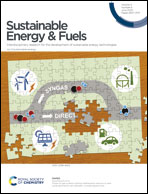ZrOCl2 as a bifunctional and in situ precursor material for catalytic hydrogen transfer of bio-based carboxides†
Abstract
The effective and economically feasible tandem synthesis of γ-valerolactone (GVL), a renowned bio-based platform molecule with great promising applications in the production of drop-in chemicals, liquid fuels and polymers, is significantly vital and challenging. Herein, we for the first time describe a direct and effective catalytic system based on ZrOCl2·8H2O capable of facilitating the one-pot one-step tandem synthesis of GVL from bio-based furfural or furfuryl alcohol in 2-propanol by integrating sequential transfer hydrogenation, ring-opening, and transfer hydrogenation–cyclization reactions. A maximum GVL yield of 63.3% and 52.1% was achieved from furfuryl alcohol and furfural at 200 °C, respectively. The synergistic effect of [ZrO(OH)2]n·xH2O species and Brønsted acid species H+, derived from in situ hydrolysis of ZrOCl2·8H2O, is accountable for its remarkable catalytic performance. Moreover, calcination of the leftover solid after tandem synthesis of GVL could fabricate a hollow microrod ZrO2 material, in which the formation of a microrod morphology and hollow structure was probably attributed to the electrostatic repulsion forces among particles in the alcohol solution and removal of generated humins/coke during the reactions within collected solids via calcination, respectively. Importantly, hollow microrod ZrO2 innovatively featuring a high BET surface area, a large amount of acid–base sites and facile active-site accessibility thereby exhibited a superior performance in the catalytic transfer hydrogenation of biomass-derived aldehydes or ketones to ZrO2 prepared by the precipitation method.



 Please wait while we load your content...
Please wait while we load your content...